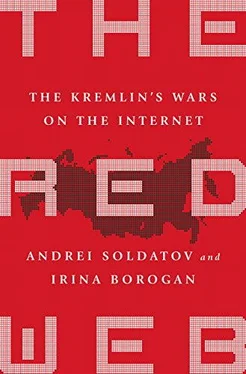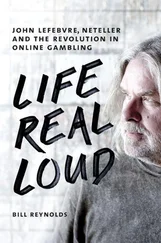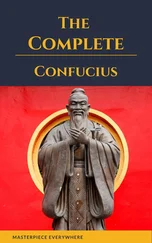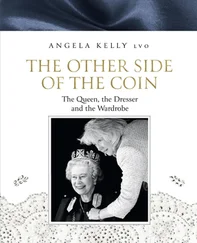Medvedev’s inner circle exploited this frustration. In December 2010 Medvedev signed a law that stipulated a retirement age of sixty instead of sixty-five for military and other state jobs. Many in Moscow wanted to believe it was a sign that Medvedev wanted to get rid of the old guard, Putin’s generation. In the spring of 2011 every move by Medvedev, every media appearance, was closely examined for signs of whether it meant he would venture to challenge Putin.
In these months Natalia Sindeeva, the owner of TV Dozhd, was desperately trying to get her channel on cable distribution networks. Finally her friends in the television industry told her that the only thing that might help the channel was to put Medvedev on the air.
The opportunity presented itself in mid-April. It was a difficult time for Sindeeva. She had just killed a short, critical poem about Medvedev that had been written for a very popular satire show on the channel Citizen Poet that often wickedly lampooned politicians, just as Kukly had in earlier years. Sindeeva had pulled the piece on grounds that it insulted the president personally. The authors of the show left the channel in protest, and Sindeeva came under a storm of criticism from liberal circles for imposing direct censorship.
Then, one day in mid-April, technicians from Digital October, a mix of digital startups, new enterprise incubators, and a conference center, which occupied space at the former chocolate factory on the other side of the wall from TV Dozhd, came to Sindeeva’s producers and asked for help. In a week they planned to host a closed meeting of a presidential council on modernization and innovation, to be chaired by Medvedev. Digital October had no cameras to record the event and asked TV Dozhd to lease them some cameras for the meeting. When Sindeeva learned about it, she at once sent an e-mail to Natalia Timakova, a spokeswoman for Medvedev. She had known Timakova for years and addressed her informally. “Natasha, we need Medvedev to come to our channel!” she wrote. Then she listed her arguments: the channel was all about innovation and modernization, the core of Medvedev’s political agenda. [8] Natalia Sindeeva, interview with authors, August 2014.
Timakova responded the same day. She wrote that Medvedev would come, adding, “You will have ten minutes.” In two days the presidential bodyguards sent officers over to check out the premises, a signal to Sindeeva it was for real. It is not entirely clear what prompted Medvedev to accept the offer—the channel’s reputation or the flare-up over Sindeeva’s decision to kill the piece critical of Medvedev.
On the morning of April 25, the day of Medvedev’s planned visit to TV Dozhd, Sindeeva pondered how to dress for it. She had never met Medvedev before and worried she would look much taller than him—Medvedev was quite short—so she abandoned formality and high heels. Instead, she chose blue jeans with holes, a white shirt, and flats.
The door from the Digital October to the premises of TV Dozhd led to the kitchen, then a long corridor, and a large open space, with the brick walls of the old factory exposed under high ceilings. In the kitchen hung a big portrait of Mikhail Khodorkovsky, the Russian oil tycoon who had been imprisoned during Putin’s first term. Timakova arrived and walked with Sindeeva along the short route through the kitchen to be taken later by Medvedev. She saw the portrait and turned to Sindeeva, “Is it correct that you want to meet Medvedev in this outfit and you have no intention to remove the portrait of Khodorkovsky?” Sindeeva made no apologies for the jeans and said, “Look, if you want us to remove the portrait, we can do that, but it would be very odd as it has been here for a long time.” Timakova said nothing, and the portrait stayed on the wall.
Finally Medvedev walked in, Timakova introduced Sindeeva, and then Medvedev saw the portrait. He smiled and said, “Well, it seems I found myself in the right place.” Sindeeva thought it was refreshingly informal. Medvedev charmed Sindeeva, and she showed Medvedev all the offices of the channel, introduced her journalists, and had Medvedev sit at the news anchor desk. At the head of the desk was the editor, Mikhail Zygar, with his co-anchor, four other journalists, and Sindeeva. All the other TV Dozhd personnel gathered behind to listen to the president. Medvedev seemed relaxed and spoke at length of the future of Internet technologies and Internet television. When Zygar asked whether he was going to run for president, Medvedev didn’t answer; instead, he laughed and spoke of his plans to teach at the university after his presidential term ended.
Instead of ten minutes, the visit lasted forty-five and was broadcast live. [9] Medvedev’s appearance on TV Dozhd, YouTube, www.youtube.com/watch?v=SwmvvjyhXmY .
“We were so charmed and inspired by him,” Sindeeva recalled. “We all liked him,” said Mikhail Zygar. [10] Mikhail Zygar, interview with authors, August 2014.
When he left, TV Dozhd’s employees and journalists applauded. “It was clear—he is a normal guy!” said Sindeeva. After the visit she wrote to Timakova, “Could you pass on from us some sort of message—let him believe in himself. Normal people will support him.” The visit changed things dramatically for the channel: officials and politicians started accepting invitations to appear on air, and the channel was included in cable television distribution packages, making it available to millions of people across Russia.
Medvedev was presented as a symbol of the new economy, or “modernization”—the economy of computer and information technologies. His most widely known personal initiative was the launching of the Skolkovo technopark eleven miles west of Moscow, a place to foster new start-ups and advanced information technology projects, modeled after Silicon Valley and funded by government contracts. Medvedev had visited Silicon Valley and Stanford University, wearing jeans and using his iPad. The Russian middle classes greeted Medvedev’s project as a welcome sign that he was committed to a new economy to compete with the old commodities industries, which were permeated by corruption.
Medvedev’s time also saw a flowering of initiative and creativity in Moscow, especially in public spaces. Modern art galleries and critics were courted by the Moscow city authorities and invited to realize their dreams in parks and old Soviet factories, which were being turned into modern exhibition centers. City authorities renovated Gorky Park. For twenty years the park looked like an out-of-time symbol of Soviet style, shabby and full of abandoned old attractions, but soon it was turned into a Russian Hyde Park. People crowded into European-style cafés, free WiFi was available throughout the park, and no chaise lounge remained empty. The middle class spread out in Moscow; they rode fancy bicycles, enjoyed the proliferation of free WiFi networks, marveled at modern, Westernized fonts on public signs, and everywhere there were IKEA chairs in parks and public areas.
The people hanging around the former chocolate factory, a new hipster mecca, clearly placed a bet on Medvedev. But his manners and interest in new technologies, so charming for Sindeeva and the journalists of TV Dozhd, didn’t make him more of a democrat. If he dared to make a bid for power, as Sindeeva urged in her e-mail to Timakova, it would not produce an open challenge to Putin in a democratic election; rather, it would mean using turf-war methods to outsmart Putin and force him to quit. For a while the Red October generation turned a blind eye to Medvedev’s rhetoric about the Arab Spring, his background, his initiatives in fighting extremism that effectively silenced dissent in the country, because he was their “normal guy,” the guy who could get rid of Putin.
Читать дальше












